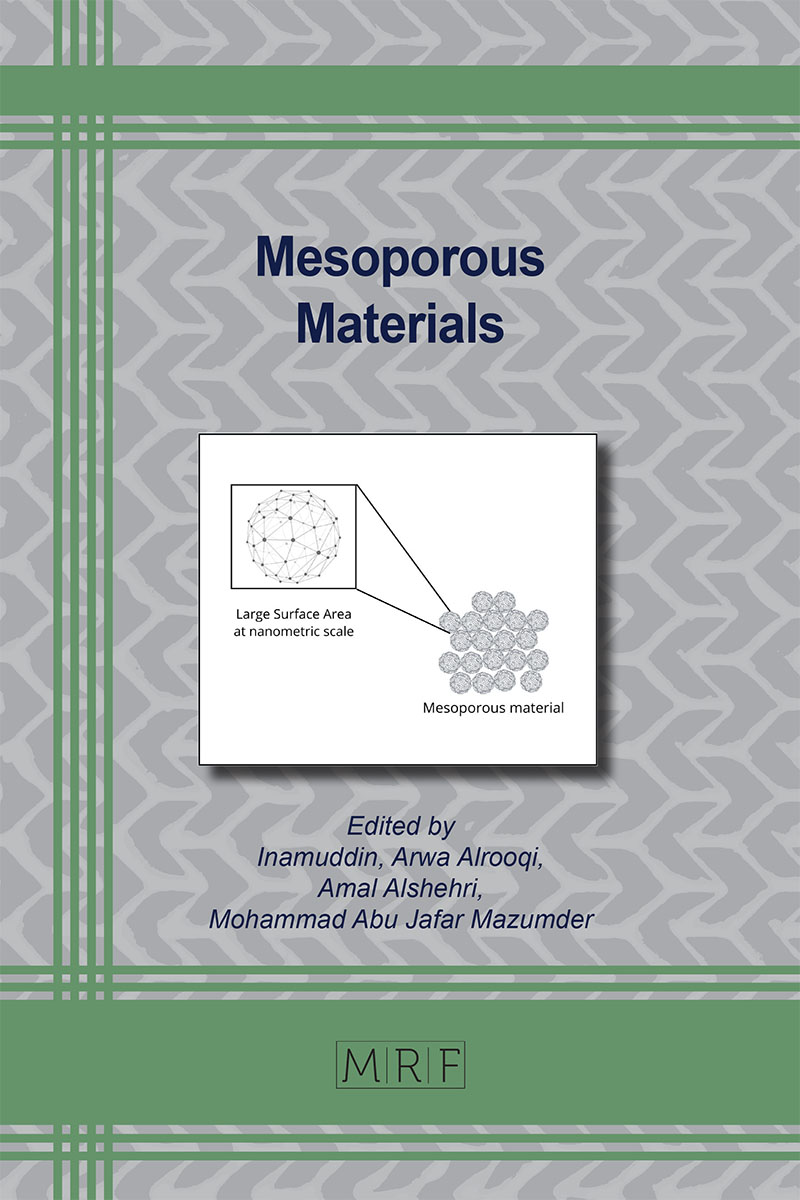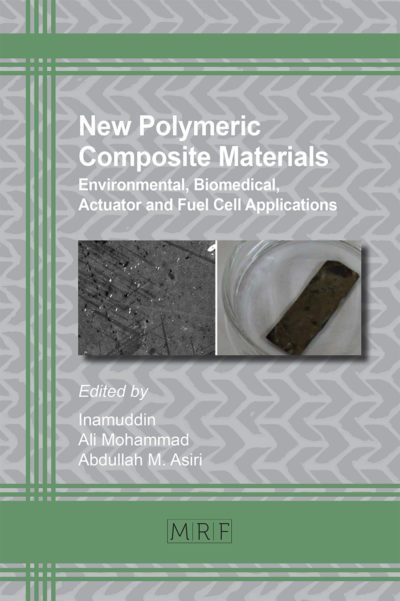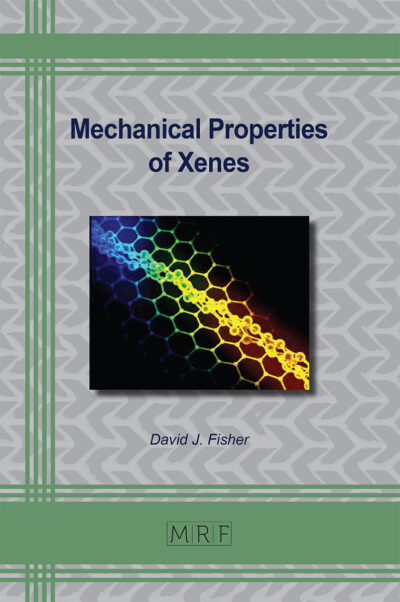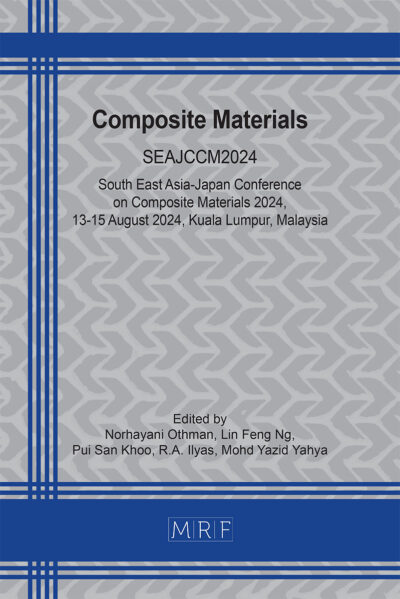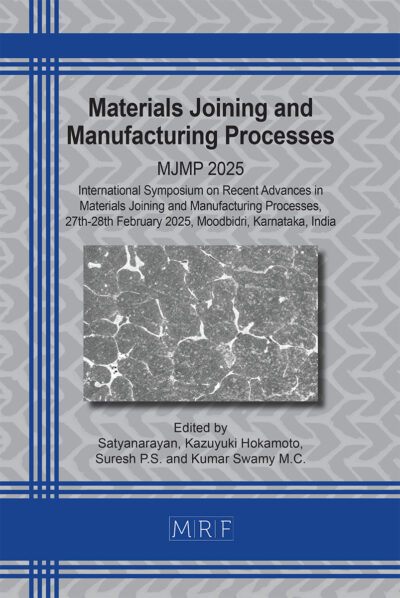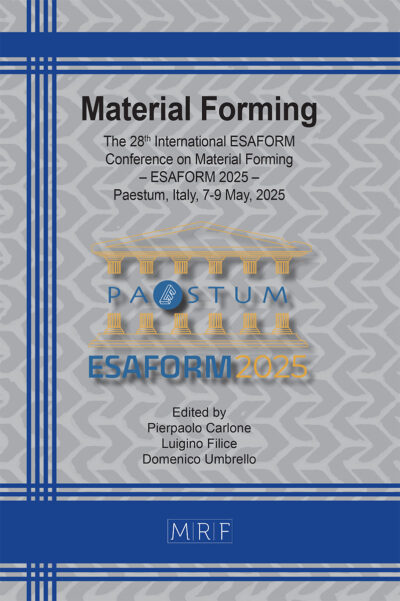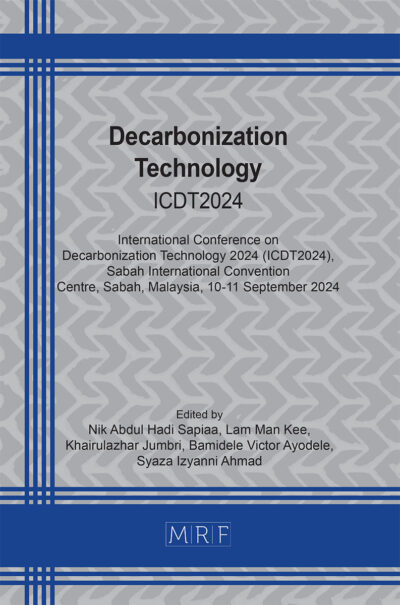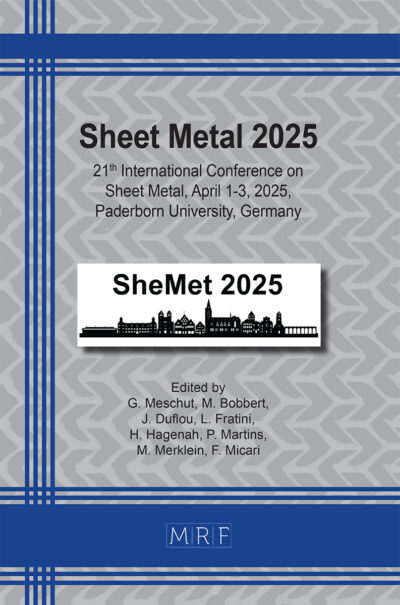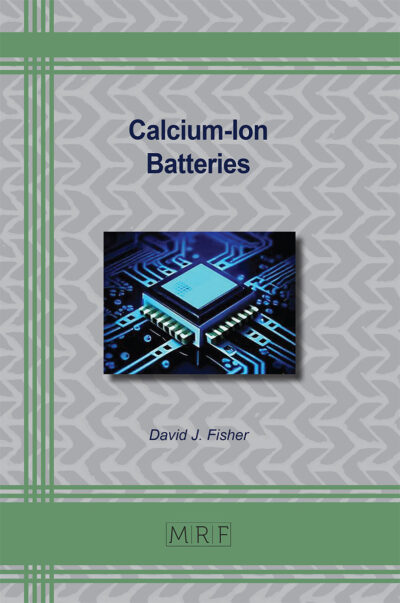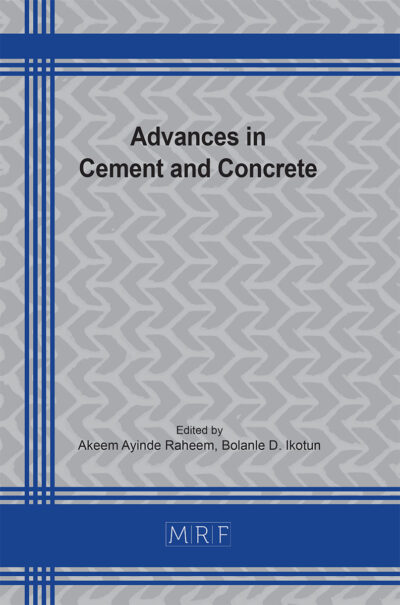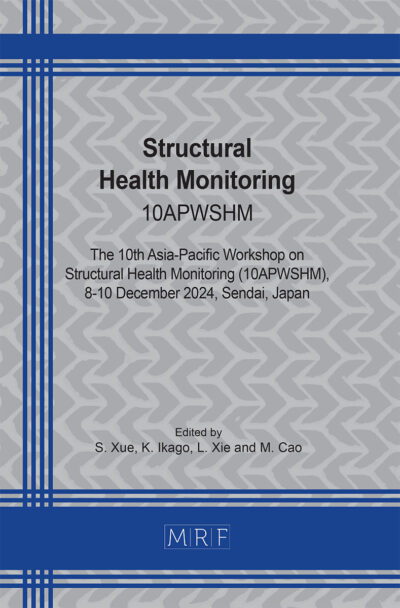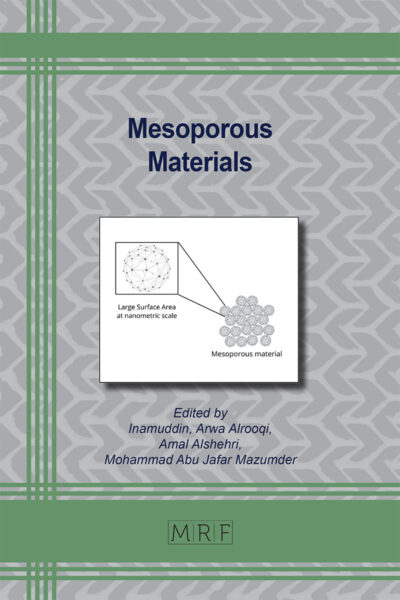Inorganic Mesoporous Materials for Sorption of Heavy Metal Ions
Yu.S. Dzyazko, M.O. Chaban
In this chapter, we consider typical inorganic mesoporous materials, which are widely used for sorption of heavy metal ions: hydrophosphates, hydrous oxides and double hydroxides of multivalent metals, and also zeolites. Oxidized graphene and its composites with these inorganic substances are also in a focus of attention. Composites based on ion exchange resins modified with mentioned inorganic compounds are discussed, since this type of polymers is also related to mesoporous materials, when they are in a swollen state. Embedded inorganic particles (non-aggregated nanoparticles, aggregates or agglomerates) affect the porous structure of the polymers changing their sorption properties.
Keywords
Hydrophosphates of Multivalent Metals, Hydrated Oxides, Zeolites, Polymer-Inorganic Composites, Ion Exchange Resins, Oxidized Graphene
Published online 3/20/2025, 39 pages
Citation: Yu.S. Dzyazko, M.O. Chaban, Inorganic Mesoporous Materials for Sorption of Heavy Metal Ions, Materials Research Foundations, Vol. 173, pp 1-39, 2025
DOI: https://doi.org/10.21741/9781644903452-1
Part of the book on Mesoporous Materials
References
[1] A. Clearfield, J.A. Stynes, The preparation of crystalline zirconium phosphate and some observation on its ion exchange behaviour, J. Inorg. Nucl. Chem. 26 (1964) 117129. https://doi.org/10.1016/0022-1902(64)80238-4
[2] G. Alberti, F. Toracca, Crystallyne insoluble salts of polybasic metals. 2. Synthesis of crystalline zirconium and titanium phosphates by direct precipitation, J. Inorg. Nucl. Chem.. 30 (1968) 317-318. https://doi.org/10.1016/0022-1902(68)80096-X
[3] F. Zhang, Y. Xie, W. Lu, X. Wang, S. Xu, X. Lei, Preparation of microspherical a-zirconium phosphate catalysts for conversion of fatty acid methyl esters to monoethanolamides, J. Colloid Interface Sci. 349 (2010) 571-577. https://doi.org/10.1016/j.jcis.2010.05.043
[4] Yu. Cheng, G.K. Chuah, The synthesis and applications of α-zirconium phosphate. Chin. Chem. Let. 31 (2020) 307-310. https://doi.org/10.1016/j.cclet.2019.04.063
[5] S. Yamanaka, M. Tanaka, Formation region and structural model of γ-zirconium phosphate, J. Inorg. Nucl. Chem. 41 (1979) 45-48. https://doi.org/10.1016/0022-1902(79)80391-7
[6] A.M. Krogh, A.P. Norby, J.C. Hanson, J.C. Hanson, T. Vogt, Preparation and characterization of a new 3-dimensional zirconium hydrogen phosphate -Zr(HPO4)2. Determination of the complete crystal structure combining synchrotron X-ray single-crystal diffraction and neutron powder diffraction. Inorg. Chem. 37 (1998) 876-881. https://doi.org/10.1021/ic971060h
[7] A. Clearfield, A.I. Bortun, L.N. Bortun, J.R. Garcia, Direct hydrothermal synthesis of zirconium phosphate and zirconium arsenate with a novel basic layered structure in alkaline media. Inorg. Chem. Commun. 1 (1998) 206208. https://doi.org/10.1016/S1387-7003(98)00055-0
[8] U. Costantino, L. Szirtes, E. Kuzmann, J Megyeri, K Lázár, Exchange of iron ions into layers of -zirconium phosphate, Solid State Ionics. 141142 (2001) 359364. https://doi.org/10.1016/S0167-2738(01)00807-4
[9] Y. Hasegawa, I. Tomita, The ion-exchange behaviour of some cations on crystalline zirconium phosphate, Bull. Chem. Soc. Jap. 4 (1974) 23892392. https://doi.org/10.1246/bcsj.47.2389
[10] S.E. Horsley, D.V. Nowell, The particle characteristics of cation exchanged -zirconium phosphate, J. Colloid Interface Sci. 49(1974) 394-402. https://doi.org/10.1016/0021-9797(74)90384-1
[11] O. Mrad, A. Abdul-Hadi, H. Arsan, Preparation and characterization of three different phases of zirconium phosphate: study of the sorption of 234Th, 238U, and 134Cs, J. Radioanal. Nucl. Chem. 287 (2011) 177-183. https://doi.org/10.1007/s10967-010-0679-1
[12] M.V. Maslova, D. Rusanova, V. Naydenov, O.N. Antzutkin, L.G. Gerasimova, Extended study on the synthesis of amorphous titanium phosphates with tailored sorption properties, J. Non-Crystalline Solids 358 (2012) 2943-2950. https://doi.org/10.1016/j.jnoncrysol.2012.06.033
[13] J.-H. Jung, H.-J. Sohn, Preparation and characterization of mesoporous zirconium phosphates from alkyl phosphates, Micropor. Mesopor. Mater. 106 (2007) 49-55. https://doi.org/10.1016/j.micromeso.2007.02.018
[14] O. Zakutevskyy, S. Khalameida, V. Sydorchuk, M. Kovtun, The effect of hydrothermal, microwave, and mechanochemical treatments of tin phosphate on sorption of some cations, Materials. 16 (2023) 4788, https://doi.org/10.3390/ma16134788. https://doi.org/10.3390/ma16134788
[15] Yu.S. Dzyazko, V.V. Trachevskii, L.M. Rozhdestvenskaya, S.L. Vasilyuk, V.N. Belyakov, Interaction of sorbed Ni(II) ions with amorphous zirconium hydrogen phosphate, Russ. J. Phys. Chem. 87 (2013) 840-845. https://doi.org/10.1134/S0036024413050063
[16] M. V. Maslova, A. S. Chugunov, L. G. Gerasimova, N. V. Konovalova, Acid-base and sorption properties of amorphous titanium phosphate, Radiochem. 55 (2013) 392-398. https://doi.org/10.1134/S1066362213040097
[17] B. Pan, Q. Zhang, W. Du, W. Zhang, B. Pan, Q. Zhang, Z. Xu, Q. Zhang, Selective heavy metals removal from waters by amorphous zirconium phosphate: Behavior and mechanism. Water Res. 41 (2007) 3103-3111. https://doi.org/10.1016/j.watres.2007.03.004
[18] B. N. Laskorin, V.A. Goldobina, V. M. Kopanev, Sorption of ions of non-ferrous metals and iron by inorganic ionites based on zirconium phosphate, Izv. Vyssh. Uchebn. Zaved., Tsvetn. Metallurg. 16 (1973) 22
[19] O. I. Zakutevskyy, T. S. Psareva, V. V. Strelko, Sorption of U(VI) ions on sol-gel-synthesized amorphous spherically granulated titanium phosphates, Russ. J. Appl. Chem. 85 (2012) 1366−1370. https://doi.org/10.1134/S107042721209011X
[20] O.V. Perlova, I.S. Ivanova, Yu.S. Dzyazko, M.O. Danilov, I.A. Rusetskii, G.Ya. Kolbasov, Sorption of U(VI) compounds on inorganic composites containing partially unzipped multiwalled nanotubes, Him. Fiz. Tekhnol. Poverhni. 12 (2021) 18-31. https://doi.org/10.15407/hftp12.01.018
[21] I. Zhuravlev, O. Zakutevsky, T. Psareva, V. Kanibolotsky, V. Strelko, M. Taffet, G. Gallios, Uranium sorption on amorphous titanium and zirconium phosphates modified by Al3+ or Fe3+ ions, J. Radioanal. Nuclear Chem. 254 (2002) 85-89. https://doi.org/10.1023/A:1020893515049
[22] P. Jiang, B. Pan, B. Pan, W. Zhang, Q. Zhang, A comparative study on lead sorption by amorphous and crystalline zirconium phosphates, Colloids Surf. A: Physicochem. Eng. Aspects 322 (2008) 108-112. https://doi.org/10.1016/j.colsurfa.2008.02.035
[23] Y. F. El-Aryan, F.Z. Alqahtany, Removal of some heavy metals from wastewater using hydrothermally synthesized zirconium phosphate as ion exchange material, Russ. J. Phys. Chem. A 95 (2021) S209-S216. https://doi.org/10.1134/S0036024421150085
[24] E.P. Horwltz, The sorption of certain transplutonium ions on amorphous zirconium phosphate, J. Inorg, Nucl. Chem. 28 (1966) 1469-1478. https://doi.org/10.1016/0022-1902(66)80180-X
[25] R. Thakkar, U. Chudasama, Synthesis and characterization of zirconium titanium phosphate and its application in separation of metal ions, J. Hazard. Mater. 172 (2009) 129-137. https://doi.org/10.1016/j.jhazmat.2009.06.154
[26] S. Ahrland, J. Albertsson, Inorganic ion exchangers. III. Equilibrium studies on zirconium phosphate gels, Acta Chem. Scand. 18 (1964) 1861-1878. https://doi.org/10.3891/acta.chem.scand.18-1861
[27] W. Janusz, V. Sydorchuk, E. Skwarek, S. Khalameida, Effect of hydrothermal treatment of zirconium phosphate xerogel on its surface groups properties and affinity adsorption to Cd (II) ions from acidic solutions, Mater.Res. Bul. 148 (2022) 111674. https://doi.org/10.1016/j.materresbull.2021.111674
[28] Y. Meng, Y. Wang, Z. Ye,, N. Wang,, C. He, Y. Zhu, T. Fujita,, H. Wu, X. Wang, Three-dimension titanium phosphate aerogel for selective removal of radioactive strontium(II) from contaminated waters, J. Environ. Manag. 325 (2023) 116424. https://doi.org/10.1016/j.jenvman.2022.116424
[29] X. Zhang, J. Shen, S. Pan, J. Qian, B. Pan, Metastable zirconium phosphate under nanoconfinement with superior adsorption capability for water treatment, Adv. Funct. Mater. 30 (2020) 1909014. https://doi.org/10.1002/adfm.201909014
[30] M. Pica, Treatment of wastewaters with zirconium phosphate based materials: a review on efficient systems for the removal of heavy metal and dye water pollutants, Molecules 26 (2021) 2392, https://doi.org/10.3390/molecules26082392. https://doi.org/10.3390/molecules26082392
[31] Q. Zhang, Q. Du, T. Jiao, B. Pan, Z. Zhang, Q. Sun, S. Wang, T. Wang, F. Gao, Selective removal of phosphate in waters using a novel of cation adsorbent: Zirconium phosphate (ZrP) behavior and mechanism, Chem. Eng. J. 221 (2013) 315-321. https://doi.org/10.1016/j.cej.2013.02.001
[32] E. H. Bailey, J. F. W. Mosselmans, P. F. Schofield, Uranyl acetate speciation in aqueous solutions An XAS study between 25°C and 250°C, Geochim. Cosmochim. Acta. 68 (2004) 1711-1722. https://doi.org/10.1016/j.gca.2003.08.024
[33] C. B. Amphlett, Inorganic Ion Exchangers, Elsevier, Amsterdam, 1964.
[34] A.B.Yaroslavtsev, Ion exchange on inorganic sorbents, Russ Chem Rev. 66 (1997) 579-596. https://doi.org/10.1070/RC1997v066n07ABEH000348
[35] L. Wang, C. Shi, L. Wang, L. Pan, X. Zhang, J.-J. Zou, Rational design, synthesis, adsorption principles and applications of metal oxide adsorbents: a review, Nanoscale. 12 (2020) 4790-4815. https://doi.org/10.1039/C9NR09274A
[36] Y. Cai, R. Chua, S. Huang, H. Ren, M. Srinivasan, Amorphous manganese dioxide with the enhanced pseudocapacitive performance for aqueous rechargeable zinc-ion battery, Chem. Eng. J. 396 (2020) 125221. https://doi.org/10.1016/j.cej.2020.125221
[37] L.M. Rozhdestvenska, M.O. Chaban, Yu. S. Dzyazko, O.V. Palchik, O.G. Dzyazko, Formation of lithium-selective sorbent in nanoreactors of the support based on titanium dioxide, Appl. Nanosci. 12 (2022) 1112-1122. https://doi.org/10.1007/s13204-021-01832-5
[38] K.O. Kudelko, L.M. Rozhdestvenska, L.M. Ponomarova, V.M. Оgenko, Anodic aluminum oxide-membrane prepared in electrolyte “oxalic acid – matter with carbon nanodots, Him. Fiz. Tehnol. Poverhni, 14 (2023) 237-248. https://doi.org/10.15407/hftp14.02.237
[39] K. Kudelko, L. Rozhdestvenska, L. Ponomarova, L. Kharkova, O. Dzyazko, Formation of nanopores in anodic oxidized aluminium affected by carbon nanodots, 2023. DOI: 10.1109/NAP59739.2023.10310955, (accessed 14 November 2023). https://doi.org/10.1109/NAP59739.2023.10310955
[40] K.O. Kudelko, L.M. Rozhdestvenska, Y.V. Borysenko, A.M. Mikhnyuk, V.Z. Barsukov, Formation and characterization of porous anodized aluminum oxide synthesized electrochemical with graphene oxide. Technologies and Engineering. 2 (2021) 49-59.
[41] K. Kudelko, L. Rozhdestvenskaya, V. Ogenko, V. Chmilenko, Formation and characterisation of porous anodized aluminum oxide, synthesized electrochemically in the presence of graphene oxide, Appl. Nanosci. 12 (2022) 1967-1976. https://doi.org/10.1007/s13204-022-02457-y
[42] T. Kamimura, S. Hara, H. Miyuki, M. Yamashita, H. Uchida, Composition and protective ability of rust layer formed on weathering steel exposed to various environments, Corrosion Sci. 48 (2006) 2799-2812. https://doi.org/10.1016/j.corsci.2005.10.004
[43] P.S. Kumar, L. Korving, K.J. Keesman, M.C.M. van Loosdrecht, G.-J. Witkamp, Effect of pore size distribution and particle size of porous metal oxides on phosphate adsorption capacity and kinetics, Chem. Eng. J. 358 (2019) 160-169. https://doi.org/10.1016/j.cej.2018.09.202
[44] O.V. Perlova, Yu.S. Dzyazko, O.V. Palchik, I.S. Martovyi, Hydrated titanium dioxide modified with potassium cobalt hexacyanoferrate (II) for sorption of cationic and anionic complexes of uranium(VI), Appl. Nanosci. 12 (2022) 651-663. https://doi.org/10.1007/s13204-021-01721-x
[45] Yu.S. Dzyazko, V.M. Ogenko, L.Ya. Shteinberg, A.V. Bildуukevich, T.V. Yatsenko, Composite adsorbents including oxidized graphene: effect of composition on mechanical durability and adsorption of pesticides, Him. Fiz. Tehnol. Poverhni. 10 (2019) 432-445. https://doi.org/10.15407/hftp10.04.432
[46] T.V. Maltseva, A.V. Pal’chik, E.O. Kudelko, S.L. Vasilyuk, K. A. Kazdobin, Impact of surface properties of hydrated compounds based on ZrO2 on the value of ionic conduction, J. Water Chem. Technol. 37 (2015) 18-24. https://doi.org/10.3103/S1063455X15010051
[47] G.A. Parks, The isoelectric points of solid oxides, solid hydroxides, and aqueous hydroxo complex systems, Chem. Rev. 65 (1965) 177-198. https://doi.org/10.1021/cr60234a002
[48] M. Kosmulski, Isoelectric points and points of zero charge of metal (hydr)oxides:50 years after Parks’ review, Adv. Colloid Interface Sci. 238 (2016) 1-61. https://doi.org/10.1016/j.cis.2016.10.005
[49] T.V. Mal’tseva, T.V. Yatsenko, E.O. Kudelko, V.N. Belyakov, The effect of introduction of manganese hydroxide and hydrated aluminum oxide on the pore structure and surface charge of Zr(IV), Ti(IV), and Sn(IV) oxyhydrates, Russ. J. Appl. Chem. 84 (2011) 756-761. https://doi.org/10.1134/S107042721105003X
[50] T.V. Mal’tseva, E.O. Kudelko, T.V. Yatsenko, Specific surface area calculation on the basis of electric double layer capacitance for porous oxyhydrate adsorbents, Rus. J. Appl. Chem. 85 (2012) 359−363. https://doi.org/10.1134/S1070427212030068
[51] O.V. Perlova, Yu.S. Dzyazko, A.A. Malinovska, A.V. Palchik, Peculiarities of U(VI) sorption on composites containing hydrated titanium dioxide and potassium-cobalt hexacyanoferrate(II), Him. Fiz. Tehnol. Poverhni. 12 (2021) 344-357. https://doi.org/10.15407/hftp12.04.344
[52] K. Kudelko, T. Maltseva, V. Belyakov, Adsorption and mobility of Cu(II), Cd(II), Pb(II) ions adsorbed on (hydr)oxide polymer sorbents MxOy·nH2O, M = Zr (IV), Ti(IV), Sn (IV), Mn(IV), Desalination Water Treatment. 35 ((2011)) 295-299.
[53] T.V. Maltseva, E.O. Kudelko, V.N. Belyakov, Adsorption of Cu(II), Cd(II), Pb(II), Cr(VI) by double hydroxides on the basis of Al oxide and Zr, Sn, and Ti oxides, Russ. J. Phys. Chem. A. 83 (2009) 2336-2339. https://doi.org/10.1134/S0036024409130263
[54] E.O. Kudelko, T.V. Mal’tseva, V. N. Belyakov, Sorption of Cr(VI) ions by oxyhydrates of MxAl1- xOy•nH2O composition, where M is Zr(IV), Ti(IV), or Sn(IV), Colloid J. 74 (2012) 313-318. https://doi.org/10.1134/S1061933X12010073
[55] Y.S. Dzyazko, V.M. Ogenko, Y.M. Volfkovich, V.E. Sosenkin, T.V. Maltseva, T.V. Yatsenko, K.O. Kudelko, Composite consisting of hydrated zirconium dioxide and graphene oxide for removal of organic and inorganic components from water. Him. Fiz. Tekhnol. Poverhni. 9 (2018) 417-431. https://doi.org/10.15407/hftp09.04.417
[56] Yu. S. Dzyaz’ko, L. M. Rozhdestvenskaya, S. L. Vasilyuk, Mobility of Cr(VI) anions in the phase of the amphoteric inorganic ion exchanger. J. Water Chem. Technol. 30 (2008) 281-287. https://doi.org/10.3103/S1063455X08050044
[57] S. Debnath, U.C. Ghosh, Nanostructured hydrous titanium(IV) oxide: Synthesis, characterization and Ni(II) adsorption behavior, Chem. Eng. J. 152 (2009) 480-491. https://doi.org/10.1016/j.cej.2009.05.021
[58] P. Trivedi, L. Axe, Modeling Cd and Zn sorption to hydrous metal oxides, Environ. Sci. Technol. 34 (2000) 2215-2223. https://doi.org/10.1021/es991110c
[59] P. Trivedi, L. Axe, A Comparison of strontium sorption to hydrous aluminum, iron, and manganese oxides, J. Colloid Interface Sci. 218 (1999) 554-563. https://doi.org/10.1006/jcis.1999.6465
[60] H. Tamura, Theorization on ion-exchange equilibria: activity of species in 2-D phases, J Colloid Interface Sci. 279 (2004) 122. https://doi.org/10.1016/j.jcis.2004.07.010
[61] S. Serrano, P.A. O’Day, D. Vlassopoulos, M.T. García-González, F. Garrido, A surface complexation and ion exchange model of Pb and Cd competitive sorption on natural soils, Geochim. Cosmochim. Acta. 73(2009) 543558. https://doi.org/10.1016/j.gca.2008.11.018
[62] M. Shi, X. Min, Y. Ke. Z. Lin. Z. Yang, S. Wang, N. Peng, X. Yan, S. Luo, J. Wu, Y. Wei, Recent progress in understanding the mechanism of heavy metals retention by iron (oxyhydr)oxides, Sci. Total. Envir. 752 (2021) 141930. https://doi.org/10.1016/j.scitotenv.2020.141930
[63] J. Liu,, R. Zhu, T. Xu, Y. Xu, F. Ge, Y. Xi, J. Zhu, H. He, 2016. Co-adsorption of phosphate and zinc(II) on the surface of ferrihydrite. Chemosphere 144, 1148-1155. https://doi.org/10.1016/j.chemosphere.2015.09.083
[64] R.G. Ford, P.M. Bertsch, K.J. Farley, Changes in transition and heavy metal partitioning during hydrous iron oxide aging. Environ. Sci. Technol 31 (1997) 2028-2033. https://doi.org/10.1021/es960824+
[65] K.G. Karthikeyan, H.A. Elliott, F.S. Cannon, Adsorption and coprecipitation of copper with the hydrous oxides of iron and aluminum. Environ. Sci. Technol. 31 (1997.) 2721-2725. https://doi.org/10.1021/es9609009
[66] J.B. Stanković, S.K. Milonjić, M.M. Kopečni, T.S. Ćeranić, Sorption of alkaline-earth cations on amorphous zirconium oxide, Colloids Surf. 46 (1990) 283-296. https://doi.org/10.1016/0166-6622(90)80172-Z
[67] X. Feng, R. Long, L. Wang, C. Liu, Z. Bai, X. Liu, A review on heavy metal ions adsorption from water by layered double hydroxide and its composites, Sep. Pur. Technol. 284 (2022) 120099. https://doi.org/10.1016/j.seppur.2021.120099
[68] G. Varga, Z. Somosi, Z. Kónya, Á. Kukovecz, I. Pálinkó, I. Szilagyi, A colloid chemistry route for the preparation of hierarchically ordered mesoporous layered double hydroxides using surfactants as sacrificial templates, J. Colloid Interface Sci. 581 (2021) 928-938. https://doi.org/10.1016/j.jcis.2020.08.118
[69] M.T. Rahman, T. Kameda, S. Kumagai, T. Yoshioka, A novel method to delaminate nitrate-intercalated MgAl layered double hydroxides in water and application in heavy metals removal from waste water, Chemosphere 203 (2018) 281-290. https://doi.org/10.1016/j.chemosphere.2018.03.166
[70] G. N. Pshinko, L.N. Puzyrnaya, B.P. Yatsik, A.A. Kosorukov, Removal of U(VI) from aqueous media with layered double hydroxide of Zn and Al, intercalated with hexacyanoferrate(II) ions, Radiochem. 57 (2015) 616-620. https://doi.org/10.1134/S1066362215060090
[71] L. Jiang, S. Xiao, J. Chen, Removal behavior and mechanism of Co(II) on the surface of Fe-Mn binary oxide adsorbent, Colloids Surf. A: Physicochem. Eng. Aspects 479 (2015) 1-10. https://doi.org/10.1016/j.colsurfa.2015.03.055
[72] W. Xu, H. Lan, H. Wang, H. Liu, J. Qu, Comparing the adsorption behaviors of Cd, Cu and Pb from water onto Fe-Mn binary oxide, MnO2 and FeOOH, Front. Environ. Sci. Eng. 9 (2015) 385-393. https://doi.org/10.1007/s11783-014-0648-y
[73] R. Liu, F. Liu, C. Hu, Z. He, H. Liu, J. Qu, Simultaneous removal of Cd(II) and Sb(V) by Fe-Mn binary oxide: Positive effects of Cd(II) on Sb(V) adsorption, J. Hazard. Mater. 300 (2015) 847-854. https://doi.org/10.1016/j.jhazmat.2015.08.020
[74] T.V. Mal’tseva, T.V. Yatsenko, E.O. Kudelko, V.N. Belyakov, The effect of introduction of manganese hydroxide and hydrated aluminum oxide on the pore structure and surface charge of Zr(IV), Ti(IV), and Sn(IV) oxyhydrates, Russ. J. Appl. Chem. 84 (2011) 756-761. https://doi.org/10.1134/S107042721105003X
[75] M. Moshoeshoe, M.S. Nadiye-Tabbiruka, V. Obuseng, A review of the chemistry, structure, properties and applications of zeolites, Amer. J. Mater. Sci. 7 (2017) 196-221.
[76] V. Yadav, M. Rani, L. Kumar, N. Singh, V. Ezhilselvi, Effect of surface modification of natural zeolite on ammonium ion removal from water using batch study: an overview, Water Air Soil Pollut. 233 (2022) 465. https://doi.org/10.1007/s11270-022-05948-4
[77] E.N. Domoroshchina, V.V. Chernyshev, G.M. Kuz’micheva, A. V. Dorokhov, L. V. Pirutko, G. V. Kravchenko, R. B. Chumakov, Changing the characteristics and properties of zeolite Y and nano-anatase in the formation of a nano-anatase/Y composite with improved photocatalytic and adsorption properties, Appl. Nanosci. 8 (2018) 19-31. https://doi.org/10.1007/s13204-018-0648-5
[78] Y. Wang, K. Liu, T. He, J. Wu, Y. Fang, Zeolite with trimodal porosity by desilication of zeolite nanocrystals aggregate, J. Solid State Chem. 194 (2012) 416-421. https://doi.org/10.1016/j.jssc.2012.04.028
[79] M. Li, C.K. Ober, Block copolymer patterns and templates, Mater. Today, 9 (2006) 30-39. https://doi.org/10.1016/S1369-7021(06)71620-0
[80] J. Perez-Ramırez, C.H. Christensen, K. Egeblad, C.H. Christensen, J.C. Groen, Hierarchical zeolites: enhanced utilisation of microporous crystals in catalysis by advances in materials design, Chem. Soc. Rev. 37 (2008) 2530-2542. https://doi.org/10.1039/b809030k
[81] R. Srivastava, Synthesis and applications of ordered and disordered mesoporous zeolites: Present and future prospective, Catalysis Today 309 (2018) 172-188. https://doi.org/10.1016/j.cattod.2017.08.017
[82] Y. Lv, B. Ma, Y. Liu, C. Wang, Y. Chen, Adsorption behavior and mechanism of mixed heavy metal ions by zeolite adsorbent prepared from lithium leach residue, Micropor. Mesopor. Mater. 329 (2022) 111553. https://doi.org/10.1016/j.micromeso.2021.111553
[83] Yu.S. Dzyazko, L.M. Rozhdestvenska, K.O. Kudelko, I.V. Fedina, L.M. Ponomaryova, G.M. Nikovska, O.G. Dzyazko, Hydrated iron oxide embedded to natural zeolite: effect of nanoparticles and microparticles on sorption properties of composites, Water, Air Soil Pollut. 233 (2022) 205. https://doi.org/10.1007/s11270-022-05681-y
[84] N. Mansouri, N. Rikhtegar, H.A.Panahi, F. Atabi, B. K. Shahraki, Porosity, characterization and structural properties of natural zeolite – clinoptilolite – as a sorbent, Env. Protect. Eng. 39 (2013) 139-151. https://doi.org/10.37190/epe130111
[85] B. Bensafi, N. Chouat, F. Djafri, High performance of carbon dioxide adsorption of mesoporous mordenite synthesized in the presence of N,N-dimethylaniline, Res. Chem. Intermed. 43 (2017):7443-7456. https://doi.org/10.1007/s11164-017-3085-2
[86] M. Thirumavalavan, Y.-T. Wang, L.-C. Lin, J.-F. Lee, Monitoring of the structure of mesoporous silica materials tailored using different organic templates and their effect on the adsorption of heavy metal ions, J. Phys. Chem. 115 (2011) 8165-8174. https://doi.org/10.1021/jp200029g
[87] L. Velarde, M.S. Nabavi, E. Escalera, M.-L. Antti, F. Akhtar, Adsorption of heavy metals on natural zeolites: A review, Chemosphere 328 (2023) 138508. https://doi.org/10.1016/j.chemosphere.2023.138508
[88] K.M. Wojciechowska, M. Król, T. Bajda, W. Mozgawa, Sorption of heavy metal cations on mesoporous ZSM-5 and mordenite zeolites, Materials 12 (2019) 3271. https://doi.org/10.3390/ma12193271
[89] Y. S. Dzyazko, I.V. Fedina, V.V. Zakharov, Y.O. Kolomiets, K.O. Kudelko, Composite ion-exchangers for the recycling of liquid waste of dairy industry, Ukrainian Chemistry Journal. 86 (2020) 38-52. https://doi.org/10.33609/2708-129X.86.5.2020.38-52
[90] Yu. Dzyazko, L. Ponomarova, L. Rozhdesvenska, K. Kudelko, A. Palchik, T. Yatsenko, Nanocomposite based on natural zeolite containing hydrated iron (iii) oxide for removal of heavy metal ions from water, 2022. DOI: 10.1109/NAP55339.2022.9934432, (accessed 10 November 2022). https://doi.org/10.1109/NAP55339.2022.9934432
[91] L. Velarde, M.S. Nabavi, E. Escalera, M.-L. Antti, F. Akhtar, Adsorption of heavy metals on natural zeolites: A review, Chemosphere 328 (2023) 138508. https://doi.org/10.1016/j.chemosphere.2023.138508
[92] S. Tangkawanit, K. Rangsriwatananon, A. Dyer, Ion exchange of Cu2+, Ni2+, Pb2+ and Zn2+ in analcime (ANA) synthesized from Thai perlite, Micropor. Mesopor. Mater. 79 (2005) 171-175. https://doi.org/10.1016/j.micromeso.2004.10.040
[93] L.-C. Lin, M. Thirumavalavan, Y.-T. Wang, J.-F. Lee, Surface area and pore size tailoring of mesoporous silica materials by different hydrothermal treatments and adsorption of heavy metal ions, Colloids and Surfaces A: Physicochem. Eng. Aspects 369 (2010) 223-231. https://doi.org/10.1016/j.colsurfa.2010.08.032
[94] S. Kocaoba, Y. Orhan, T. Akyüz, Kinetics and equilibrium studies of heavy metal ions removal by use of natural zeolite, Desalination 214 (2007) 1-10. https://doi.org/10.1016/j.desal.2006.09.023
[95] A.A.M. El-Kamash, A.A. Zaki, M. Abed El Geleel, Modeling batch kinetics and thermodynamics of zinc and cadmium ions removal from waste solutions using synthetic zeolite, J. Hazard. Mater. B127 (2005) 211-220. https://doi.org/10.1016/j.jhazmat.2005.07.021
[96] M. Hong, L. Yu, Y. Wang, J. Zhang, Z. Chen, L. Dong, Q. Zan, R. Li, Heavy metal adsorption with zeolites: The role of hierarchical pore architecture, Chem. Eng. J. 359 (2019) 363-372. https://doi.org/10.1016/j.cej.2018.11.087
[97] T.M. McCoy, G. Turpin, B.M. Teo, R.F. Tabor, Graphene oxide: a surfactant or particle? Curr. Opin. Colloid Interface Sci. 39 (2019) 98-109. https://doi.org/10.1016/j.cocis.2019.01.010
[98] L. Staudenmaier, Verfahren zur Darstellung der Graphitsaure. Ber. Deut. Chem. Ges. 31 (1898) 1481-1487. https://doi.org/10.1002/cber.18980310237
[99] B.C. Brodie, Sur le poids atomique du graphite. Ann. Chim. Phys. 59 (1860) 466-472.
[100] W.S. Hummers, R.E. Offeman, Preparation of graphitic oxide. J Am Chem Soc 80 (1958) 1339-1339. https://doi.org/10.1021/ja01539a017
[101] Y. Wang, Z. Wang, Z. Gu, J. Yang, J. Liao, Y. Yang, N. Liu, J. Tang, Uranium(VI) sorption on graphene oxide nanoribbons derived from unzipping of multiwalled carbon nanotubes. J. Radioanalyt. Nucl. Chem. 304 (2015) 1329-1337. https://doi.org/10.1007/s10967-015-3981-0
[102] M.O. Danilov, I.A. Rusetskii, G.I. Dovbeshko, A. Nikolenko, S. Fomanyuk, G.Ya. Kolbasov, Electrochemical synthesis partially unzipped multi-walled carbon nanotubes as electrode materials for fuel cells, ECS Trans. 95 (2019) 273. https://doi.org/10.1149/09501.0273ecst
[103] M.O. Danilov, G.I. Dovbeshko, I.A. Rusetskii, V.I. Pekhnyo, A.S. Nikolenko, G.Ya. Kolbasov, Partially unzipped multi-walled carbon nanotubes-promising material for oxygen electrodes of fuel cells. Appl. Phys. A 126 (2020) 764. https://doi.org/10.1007/s00339-020-03951-2
[104] Y. Dzyazko, V. Ogenko, Polysaccharides: an efficient tool for fabrication of carbon nanomaterials, in: Inamuddin, M.I. Ahamed, R. Boddula, T. Altalhi (Eds.), Polysaccharides: Properties and Applications. Wiley, Hoboken, 2021, pp. 337-366. https://doi.org/10.1002/9781119711414.ch16
[105] R.J. Seresht, M. Jahanshahi, A. Rashidi, A.A. Ghoreyshi, Synthesize and characterization of graphene nanosheets with high surface area and nano-porous structure. Appl. Surf. Sci. 276 (2013) 672-681. https://doi.org/10.1016/j.apsusc.2013.03.152
[106] M.J. McAllister, J.-L. Li, D.H. Adamson, H.C. Schniepp, A.A. Abdala, J. Liu, M. Herrera-Alonso, D.L. Milius, R. Car, R.K. Prud’homme, I.A. Aksay, Single sheet functionalized graphene by oxidation and thermal expansion of graphite. Chem. Mater. 19 (2007) 4396-4404. https://doi.org/10.1021/cm0630800
[107] D.R. Dreyer, S. Park, C.W. Bielawski, R.S. Ruoff, The chemistry of graphene oxide. Chem. Soc. Rev. 39 (2010) 228-240. https://doi.org/10.1039/B917103G
[108] Y.M. Volfkovich, A.Y. Rychagov, V.E. Sosenkin, O.N. Efimov, M.I. Os’makov, Measuring the specific surface area of carbon nanomaterials by different methods, Russ. J. Electrochem. 50 (2014) 1099-1101. https://doi.org/10.1134/S1023193514110111
[109] Yu. Dzyazko, Yu. Volfkovich, O. Perlova, L. Ponomaryova, N. Perlova, E. Kolomiets, Effect of porosity on ion transport through polymers and polymer-based composites containing inorganic nanoparticles (review), Springer Proc. Phys. 222 (2019) 235-253. https://doi.org/10.1007/978-3-030-17755-3_16
[110] Y.M. Shulga, S.A. Baskakov, Y.V. Baskakova, Y.M. Volfkovich, N.Y. Shulga, E.A. Skryleva, Y.N. Parkhomenko, K.G. Belay, G.L. Gutsev, A.Y. Rychagov, V.E. Sosenkin, I.D. Kovalev, Supercapacitors with graphene oxide separators and reduced graphite oxide electrodes, J Power Sources 279 (2015) 722-730. https://doi.org/10.1016/j.jpowsour.2015.01.032
[111] R. Sitko, E. Turek, B. Zawisza, E. Malicka, E. Talik, J. Heimann, A. Gagor, B. Feist, R. Wrzalik, Adsorption of divalent metal ions from aqueous solutions using graphene oxide. Dalton Trans., 42 (2013) 5682-5689. https://doi.org/10.1039/c3dt33097d
[112] Zhao G., Li J., Ren X., Chen Ch., Wang X. Few-layered graphene oxide nanosheets as superior sorbents for heavy metal ion pollution management. Environ. Sci. Technol. 45 (2011) 10454-10462. https://doi.org/10.1021/es203439v
[113] J. Huang, Z. Wu, L. Chen, Y. Sun, Surface complexation modeling of adsorption of Cd(II) on graphene oxides, J. Molec. Liquids 209 (2015) 753-758. https://doi.org/10.1016/j.molliq.2015.06.047
[114] P. Tan, J. Sun, Y. Hu, Z. Fang, Q. Bi, Y. Chen, J. Cheng, Adsorption of Cu2+, Cd2+ and Ni2+ from aqueous single metal solutions on graphene oxide membranes. J. Hazard. Mater. 297 (2015) 251-260. https://doi.org/10.1016/j.jhazmat.2015.04.068
[115] S.-T. Yang, Y. Chang, H. Wang, G. Liu, S. Chen, Y. Wang, Y. Liu, A. Cao, Folding/aggregation of graphene oxide and its application in Cu2+ removal, J. Colloid. Interface Sci. 351 (2010) 122-127. https://doi.org/10.1016/j.jcis.2010.07.042
[116] Z. Li, F. Chen, L. Yuan, Y. Liu, Y. Zhao, Z. Chai, W. Shi, Uranium(VI) adsorption on graphene oxide nanosheets from aqueous solutions, Chem. Eng. J. 210 (2012) 539 -546. https://doi.org/10.1016/j.cej.2012.09.030
[117] Yu.S. Dzyazko, Yu.M. Volfkovich, M.O. Chaban, Composites containing inorganic ion exchangers and graphene oxide: hydrophilic-hydrophobic and sorption properties (review), Springer Proc. Phys. 246 (2020) 93-110. https://doi.org/10.1007/978-3-030-51905-6_8
[118] M. Patel, H. Lanakapati, K. Maheria, Efficient removal of Pb2+, Cd2+, and Hg2+ from wastewater using advanced graphene oxide-zirconium hybrid composite, ACS Appl. Eng. Mater. 2 (2024) 1542−1560. https://doi.org/10.1021/acsaenm.4c00090
[119] S.R. Al-Mhyawi, D.M.D. Bader, M.A. Bajaber, S.M. Abd El Dayem, A.H. Ragab, K. A. Abd El-Rahem, M.A. Gado, B.M. Atia, M.F. Cheira, Zirconium oxide with graphene oxide anchoring for improved heavy metal ions adsorption: Isotherm and kinetic study, J. Mater. Res. Technol. 22 (2023) 3058-3074. https://doi.org/10.1016/j.jmrt.2022.11.121
[120] S. Pourbeyram, Effective removal of heavy metals from aqueous solutions by graphene oxide−zirconium phosphate (GO−Zr-P) nanocomposite, Ind. Eng. Chem. Res. 55 (2016) 5608−5617. https://doi.org/10.1021/acs.iecr.6b00728
[121] I.O. Ali, S.M. El‑Sheikh, T.M. Salama, E.K. Abdel‑Khalek, M.S. Thabet, M.F. Bakr, M.H. Fodial, Novel composites of multifunctional NaP zeolite/graphene oxide for highly efficient removal of Fe(III) from aqueous solution, J. Inorg. Organomet. Polym. 31 (2021) 577-590. https://doi.org/10.1007/s10904-020-01748-7
[122] D Smržová, L Szatmáry, P Ecorchard, A Machálková, M Maříková, P Salačová, M Straka, Carbon and zeolite-based composites for radionuclide and heavy metal sorption, Heliyon 8 (2022) e12293. https://doi.org/10.1016/j.heliyon.2022.e12293
[123] M. Liu, C. Chen, J. Hu, X. Wu, X. Wang, Synthesis of magnetite/graphene oxide composite and application for cobalt (II) removal, J. Phys. Chem. C 115 (2011) 25234-25240. https://doi.org/10.1021/jp208575m
[124] W.C. Elmore, Ferromagnetic colloids for studying magnetic structures, Phys. Rev. 54 (1938) 309-310. https://doi.org/10.1103/PhysRev.54.309
[125] J. Yan, R. Li, Simple and low-cost production of magnetite/graphene nanocomposites for heavy metal ions adsorption, Sci. Total Envir. 813 (2022) 152604. https://doi.org/10.1016/j.scitotenv.2021.152604
[126] Y. Dzyazko, O. Perlova, I. Martovyi, Advanced carbon nanomaterials and their composites for removal of U(VI) compounds from aqueous solutions, Springer Proc. Phys. 279 (2023) 177-194. https://doi.org/10.1007/978-3-031-18096-5_9
[127] Z. Yang, H. Yan, H. Yang, H. Li, A. Li, R. Cheng, Flocculation performance and mechanism of graphene oxide for removal of various contaminants from water. Water Res. 47 (2013) 3037-3046. https://doi.org/10.1016/j.watres.2013.03.027
[128] G. Sheng, C. Huang, G. Chen, J. Sheng, X. Ren, B. Hu, J. Ma, X. Wang, Y. Huang, A. Alsaedi, T. Hayat, Adsorption and co-adsorption of graphene oxide and Ni(II) on iron oxides: A spectroscopic and microscopic investigation. Environ. Pollut. 233 (2018) 125-131. https://doi.org/10.1016/j.envpol.2017.10.047
[129] Y. Dzyazko, A. Omel’chuk, Porous Ionic Polymers, in: Inamuddin, M.I. Ahamed, R. Boddula (Eds.), Porous Polymer Science and Applications, CRC Press, Boca Raton, London, New York: 2022, pp. 37-59. https://doi.org/10.1201/9781003169604-3
[130] N. Kononenko, V. Nikonenko, D. Grande, C. Larchet, L. Dammak, M. Fomenko, Yu. Volfkovich, Porous structure of ion exchange membranes investigated by various technique. Adv. Colloid Interface Sci. 246 (2017) 196216. https://doi.org/10.1016/j.cis.2017.05.007
[131] Yu. S. Dzyazko, L. N. Ponomareva, Yu. M. Volfkovich, V.E. Sosenkin, Effect of the porous structure of polymer on the kinetics of Ni2+ exchange on hybrid inorganic-organic ionites, Russ. J. Phys. Chem. 86 (2012) 913-919. https://doi.org/10.1134/S0036024412060088
[132] F. Helfferich, Ion Exchange, second ed., Dover, New Vork, 1995.
[133] W.Y. Hsu, T.D. Gierke, Ion transport and clustering in Nafion perfluorinated membranes. J. Membr. Sci. 13 (1983) 307-326. https://doi.org/10.1016/S0376-7388(00)81563-X
[134] H.E. Andrada, M.B. Franzoni, A.C. Carreras, F.V. Chávez, Dynamics and spatial distribution of water in Nafion 117 membrane investigated by NMR spin-spin relaxation, Int. J. Hydrogen Energy 43 (2018) 8936-8943. https://doi.org/10.1016/j.ijhydene.2018.03.124
[135] K.A. Mauritz, R.B. Moore, State of understanding of Nafion, Chem. Rev. 104 (2004) 45354585. https://doi.org/10.1021/cr0207123
[136] Yu.S. Dzyazko, L.N. Ponomareva, Y.M. Volfkovich, V.E. Sosenkin, V.N. Belyakov, Conducting properties of a gel ionite modied with zirconium hydrophosphate nanoparticles, Russ. J. Electrochem. 49 (2013) 209-215. https://doi.org/10.1134/S1023193513030075
[137] Yu.Dzyazko, L. Ponomarova, Yu. Volfkovich, V. Tsirina, V. Sosenkin, N. Nikolska, V. Belyakov, Influence of zirconium hydrophosphate nanoparticles on porous structure and sorption capacity of the composites based on ion exchange resin, Chem. Chem. Technol. 10 (2016) 329-335. https://doi.org/10.23939/chcht10.03.329
[138] Yu.S. Dzyazko, O.V. Perlova, N.A. Perlova, Yu.M. Volfkovich, V.E. Sosenkin, V.V. Trachevskii, V.F. Sazonova, A.V, Palchik, Composite cation-exchange resins containing zirconium hydrophosphate for purification of water from U(VI) cations, Desalination and Water Treatment. 69 (2017) 142-152. https://doi.org/10.5004/dwt.2017.0686
[139] Yu.S. Dzyazko, L.N. Ponomaryova, Yu.M. Volfkovich, V.E. Sosenkin, V.N. Belyakov, Polymer ion-exchangers modified with zirconium hydrophosphate for removal of Cd2+ ions from diluted solutions, Separ. Sci. Technol. 48 (2013) 2140-2149. https://doi.org/10.1080/01496395.2013.794434
[140] Yu.S. Dzyazko, L.N. Ponomaryova, Yu.M. Volfkovich, V.V. Trachevskii, A.V. Palchik, Ion-exchange resin modified with aggregated nanoparticles of zirconium hydrophosphate. Morphology and functional properties, Micropor Mesopor Mater. 198 (2014) 55-62. https://doi.org/10.1016/j.micromeso.2014.07.010
[141] L. Ponomarova, Yu. Dzyazko, Yu. Volfkovich, V.E. Sosenkin, S. Scherbakov, Effect of incorporated inorganic nanoparticles on porous structure and functional properties of strongly and weakly acidic ion exchangers, Springer Proc. Phys. 214 (2018) 63-77. https://doi.org/10.1007/978-3-319-92567-7_4
[142] Y.S. Dzyazko, L.N. Ponomaryova, L.M. Rozhdestvenskaya, S.L. Vasilyuk, V.N. Belyakov. Electrodeionization of low-concentrated multicomponent Ni2+-containing solutions using organic-inorganic ion-exchangers, Desalination. 342 (2014) 52-60. https://doi.org/10.1016/j.desal.2013.11.030
[143] Yu. Dzyazko, E. Kolomyets, Yu. Borysenko, V. Chmilenko, I. Fedina, Organic-inorganic sorbents containing hydrated zirconium dioxide for removal of chromate anions from diluted solutions, Mater. Today: Proc. 6 (2019) 260-269. https://doi.org/10.1016/j.matpr.2018.10.103
[144] Y.O. Kolomiyets, V.N. Belyakov, A.V. Palchik, T.V. Maltseva, Effect of incorporation of hydrated oxides of Sn(IV), Zr(IV) and Fe(III) in a matrix of the anion exchanger Dowex SBR-P on the sorption capacity towards the Arsenic (V) anions, Int. J. Water Wastewater Treat. 2 (2016) http://dx.doi.org/10.16966/2381-5299.120. https://doi.org/10.16966/2381-5299.120
[145] E.O. Kolomiets, T.V. Maltseva, Yu.S. Dzyazko, Organic-inorganic ion-exchangers for selective electrodeionization of diluted aqueous solutions. Voprosy Khimii i Khimicheskoi Tekhnologii. 1 (2019) 18-25. https://doi.org/10.32434/0321-4095-2019-122-1-18-25
[146] T.V. Maltseva, E.O. Kolomiets, Yu.S. Dzyazko, S. Scherbakov, Composite anion-exchangers modified with nanoparticles of hydrated oxides of multivalent metals, Appl. Nanosci. 9 (2019) 997-1004. https://doi.org/10.1007/s13204-018-0689-9
[147] T.V. Mal’tseva, E.A. Kolomiets, S.L.Vasilyuk Hybrid adsorbents based on hydrated oxides of Zr(IV), Ti(IV), Sn(IV), and Fe(III) for arsenic removal. J Water Chem Technol. 39 (2017) 214 – 219. https://doi.org/10.3103/S1063455X17040063
[148] Ye.O. Kolomiyets, E.O. Kudelko, Т.V. Maltseva, S.L. Vasilyuk, YuS. Dzyazko, Adsorption of arsenic, chromium, lead, cadmium by adsorbents on the basis of Zr(IV), Ti(IV), Sn(IV), Al(III), Fe(III) oxides. Water and Water Purification Technologies. Scientific and Technical News. 22 (2018) 11-19. https://doi.org/10.20535/2218-93002212018144235
[149] W. Mu, S. Du, Q. Yu, X. Li, H. Wei, Y. Yang, S. Peng, Highly efficient removal of radioactive 90Sr based on sulfonic acid functionalized α-zirconium phosphate nanosheets, Chem. Eng. J. 361 (2019) 538-546. https://doi.org/10.1016/j.cej.2018.12.110
[150] Y.K. Kim, K. J. Lee Synthesis of a magnetic composite resin and its cobalt removal characteristics in aqueous solution, J. Nucl. Sci. Technol. 38 (2001) 785-792. https://doi.org/10.3327/jnst.38.785
[151] J.-K. Moon, K.-W. Kim, C.-H. Jung, Y.-G. Shul, E.-H. Lee, Preparation of organic-inorganic adsorbent beads for removal of radionuclides and heavy metal ions, J. Radioanal. Nucl. Chem. 246 (2000) 299-307. https://doi.org/10.1023/A:1006714322455
[152] Inamuddin, S.A. Khan, W.A. Siddiqu, A.A. Khan, Synthesis, characterization and ion-exchange properties of a new and novel organic-inorganic hybrid cation-exchanger: Nylon-6,6, Zr(IV) phosphate, Talanta 71 (2007) 841-847. https://doi.org/10.1016/j.talanta.2006.05.042
[153] W.A. Siddiqui, S.A. Khan, Inamuddin, Synthesis, characterization and ion-exchange properties of a new and novel ‘organic-inorganic’ hybrid cation-exchanger: Poly(methyl methacrylate) Zr(IV) phosphate, Colloids Surf. A: Physicochem. Eng. Aspects 295 (2007) 193-199. https://doi.org/10.1016/j.colsurfa.2006.08.053
[154] L.C.A. Molina, G.A.V. Magalhães-Ghiotto, L. Nichi, Y.S. Dzyazko, R. Bergamasco, Membranes modified with rigid polymer for processing solutions of vegetable proteins, Acta Periodica Technologica 54 (2023) 313-324. https://doi.org/10.2298/APT2354313M
[155] L.M. Rozhdestvenskaya, Y.S. Dzyazko, E.O. Kudelko, S.L. Vasilyuk, V.N. Belyakov, Desalination of glycerol-water solutions by electrodyalysis using the organo-inorganic membranes, J. Water Chem. Technol. 39 (2017) 26-32. https://doi.org/10.3103/S1063455X17010052
[156] Y. Zmievskii, L. Rozhdestvenska, Y. Dzyazko, L. Kornienko, V. Myronchuk, A. Bildukevich, A. Ukrainetz, Organic-inorganic materials for baromembrane separation, Springer Proc. Phys. 195 (2017) 675-685. https://doi.org/10.1007/978-3-319-56422-7_51
[157] Y. Dzyazko, L. Rozhdestvenska, K. Kudelko, V. Ogenko, Y. Kolomiets, Membranes modified with advanced carbon nanomaterials (review), Springer Proc. Phys. 263 (2021) 151-174. https://doi.org/10.1007/978-3-030-74741-1_10
[158] L. Rozhdestvenska, K. Kudelko, Y. Kolomiets, Y. Dzyazko, V. Ogenko, Membranes functionalized with 1d, 2d and 3d carbon materials, Ukrainian Chemistry Journal. 87 (2021) 79-110. https://doi.org/10.33609/2708-129X.87.04.2021.79-110
[159] L. Rozhdestvenska, K. Kudelko, V. Ogenko, O. Palchik, T. Plisko, A.Bildyukevich, V. Zakharov, Yu. Zmievskii, O. Vishnevskii, Filtration membranes containing nanoparticles of hydrated zirconium oxide-graphene oxide, Springer Proc. Phys. 246 (2020) 757-771. https://doi.org/10.1007/978-3-030-51905-6_51
[160] K.O. Kudelko, L.M. Rozhdestvenska, A.A. Verbytska, Y.V. Borysenko, V.Z. Barsukov, Microfiltration membranes modified with hydrated zirconium dioxide containing carbon nanodots. Technologies and Engineering. 5 (2022) 43-55.
[161] Y.O. Kolomiiets, Y.S. Dzyazko, Sorbents based on non-carbonized vegetable raw materials, Ukrainian Chemistry Journal. 88 (2022) 37-68. https://doi.org/10.33609/2708-129X.88.05.2022.37-68
[162] Y.O. Kolomiiets, O.V. Palchik, Yu.S. Dzyazko, T.V. Yatsenko, L.M. Ponomaryova, V.M. Ogenko, Sorbents based on biopolymers of different origin containing magnetite for removal of oil products and toxic ions from water. Him. Fiz. Tehnol. Poverhni. 14 (2023) 121-132. https://doi.org/10.15407/hftp14.01.121

